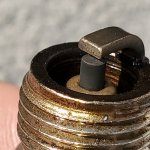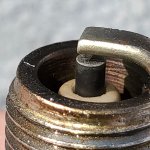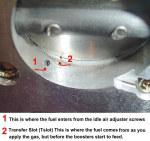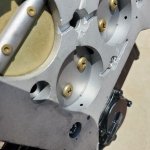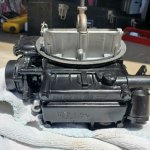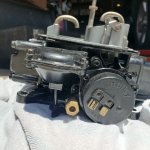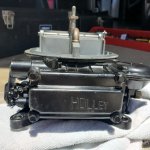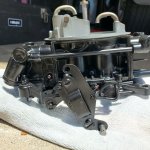Adjusting the fuel/air mixture on a 1992 5.8 L with a Holly 4 bbl
There are 2 different methods:
1) Per an original Shop Manual (615 pages)
Idle speed screw just touching but not moving the cam
Mixtures screws seated then back out 7/8 (for my engine)
Start engine and warm up
Disconnect throttle with engine running (it would be hard to start with no throttle to pump or to raise the idle)
Shift into fwd gear
Turn the mixture screws IN until you get an rpm drop (this is called a “lean roll”)
Then turn them OUT until you get the RPM in the manual (550-650)
(This assumes that you will be at an idle Below the specs when you get the lean drop. What if you are already above it?)
While you are turning the screws back out, If the idle begins to drop due to the mixture too rich, turn them to get it running smoothly
Recheck the idle speed and use the idle speed screw to adjust
(But we just set the idle using the mixture screws, we have not used the idle stop screw to set the idle at all
In the first step the idle speed screw was set to not be affecting the idle)
OR
2) Per a Clymer manual for 86 – 93 boats
Start and warm up engine
Use the idle speed screw to adjust the rpm to the specification (this is different from above)
Adjust idle mixture to obtain the highest rpm (no lean roll method is used)
Readjust the idle speed screw to obtain rpm per the manual
Which is best and why?
Last time I used the Clymer procedure and I think I'm running a bit rich. Take a look at the pictures of the spark plugs
There are 2 different methods:
1) Per an original Shop Manual (615 pages)
Idle speed screw just touching but not moving the cam
Mixtures screws seated then back out 7/8 (for my engine)
Start engine and warm up
Disconnect throttle with engine running (it would be hard to start with no throttle to pump or to raise the idle)
Shift into fwd gear
Turn the mixture screws IN until you get an rpm drop (this is called a “lean roll”)
Then turn them OUT until you get the RPM in the manual (550-650)
(This assumes that you will be at an idle Below the specs when you get the lean drop. What if you are already above it?)
While you are turning the screws back out, If the idle begins to drop due to the mixture too rich, turn them to get it running smoothly
Recheck the idle speed and use the idle speed screw to adjust
(But we just set the idle using the mixture screws, we have not used the idle stop screw to set the idle at all
In the first step the idle speed screw was set to not be affecting the idle)
OR
2) Per a Clymer manual for 86 – 93 boats
Start and warm up engine
Use the idle speed screw to adjust the rpm to the specification (this is different from above)
Adjust idle mixture to obtain the highest rpm (no lean roll method is used)
Readjust the idle speed screw to obtain rpm per the manual
Which is best and why?
Last time I used the Clymer procedure and I think I'm running a bit rich. Take a look at the pictures of the spark plugs




















